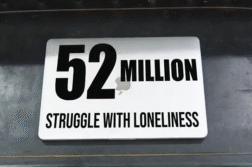SAN DIEGO, Calif. (Ivanhoe Newswire) — The pandemic has brought to light many mental health issues. One that it exacerbated … hoarding. It re-enforced some beliefs about the need to save items. But for millions, it’s more than just buying toilet paper and Clorox. For many, it’s a disorder that began in childhood and went undiagnosed for years, and then later in life, took control forbidding its victims from parting with possessions. Now a new therapy is helping these patients regain control of their lives. Ivanhoe has the details.
Ri Parrish is one of 19 million Americans diagnosed with hoarding disorder.
“It makes you feel a little immobile,” said Parrish.
Getting a divorce and coming out as transgender spiked Parrish’s anxiety, kicking her disorder into overdrive.
“You just feel like there’s, there’s no hope,” explained Parrish.
“Their experience of this is so distressing when they do try to discard items that they just simply feel like they cannot,” stated Catherine Ayers, PhD, a psychiatrist with UC San Diego Health.
That’s why professors at UC San Diego created discarding exposure therapy. Patients work through their items while keeping a journal. During an in-home session, Parrish and her therapist, Phillip Salas, talk through discarding items.
“A majority of them are not easy because they either go back to a relationship or they go back to a good time or a bad time,” said Parrish.
Most hoarders are dealing with other mental disorders. Fifty percent have major depressive disorder and 48 percent have either anxiety or social phobia. So, therapists need to treat the entire person.
“It’s the only mental health condition besides dementia that gets worse with age,” shared Ayers.
Parrish is making progress. Tackling her demons, one row, one box, one item … at a time.
“I know long-term, everything’s going to get better for me,” smiled Parrish.
Most people with hoarding disorder have a first degree relative with the disorder. The average age of a hoarder is 50 years old. But signs begin to appear during the teen years. For example, they get upset when their items are discarded. And although it’s not curable, it is treatable.
If you have a hoarder in your family, it’s important not to take charge and start cleaning up or throwing out items for them. It will lead to a strained relationship, a lack of trust, and people being more resistant to therapy.
Contributors to this news report include: Marsha Lewis, Producer; Roque Correa, Editor and Videographer.
BATTLING YOUR DEMONS: HOARDERS CLEAN HOUSE
REPORT #2884
BACKGROUND: Hoarding disorder is when a person excessively saves items that others may view as worthless. This person has difficulty getting rid of possessions, leading to chaos that disrupts their ability to use their living and/or workspaces. Hoarding is different than collecting. Collectors look for specific items, such as model cars or stamps, and organizes them or displays them. In most cases, hoarders save items that they feel they may need in the future, are valuable, or have sentimental value. Some may also feel safer surrounded by the things they save. Hoarding disorder occurs in an estimated 2 to 6 percent of the population and often leads to distress and problems functioning. Research shows hoarding disorder is more common in males than females and among older adults. Three times as many adults 55 to 94 years old are affected by hoarding disorder compared to adults 34 to 44 years old.
(Source: https://www.psychiatry.org/patients-families/hoarding-disorder/what-is-hoarding-disorder)
CAUSES AND TREATMENT: There is no known cause of hoarding disorder, but doctors have discovered several risk factors associated with the condition. Some of these include having a relative with the disorder; a brain injury that triggers the need to save things; a traumatic life event; mental disorders such as depression or obsessive-compulsive disorder; uncontrollable buying habits; or the inability to pass up free items such as coupons and flyers. Cognitive-behavioral therapy (CBT) is a common treatment where people learn to understand why they hoard and how to feel less anxiety when throwing away items. Specialists will teach organization and decision-making skills that will help a person better manage their possessions. Some doctors use medications called antidepressants to treat hoarding disorder. These medicines can help to improve symptoms. Often, the combination of medications and CBT are utilized in order to reduce symptoms more effectively.
(Source: https://my.clevelandclinic.org/health/diseases/17682-hoarding-disorder)
NEW PSYCHOTHERAPY APPROACH: A recent study evaluated a follow-up treatment to CBT for hoarding disorder called compassion-focused therapy (CFT). The study concentrated on CFT because of its ability to help regulate a patient’s emotions and improve their self-perception. The technique helps patients recognize their behavioral and thought patterns and teaches them how to self-soothe. Researchers found that using CFT as a follow-up treatment to CBT reduced patients’ hoarding symptoms. More than 70 percent of people using this method lowered their symptoms under the standard level for a clinically significant hoarding disorder. A 2020 study found that hoarders display a reduced ERN, electrical signal in the brain called error-related negativity, outside of decision-making, too. Researchers found that the stunted brain signal occurs in hoarders across all emotional states, not just during times of distress. The study’s findings adds to prior research that these abnormal brain signals could be related to hoarding symptoms.
* For More Information, Contact:
Michelle Brubaker, Communications and Media Relations
(858) 210-0854
Free weekly e-mail on Medical Breakthroughs from Ivanhoe. To sign up: http://www.ivanhoe.com/ftk



